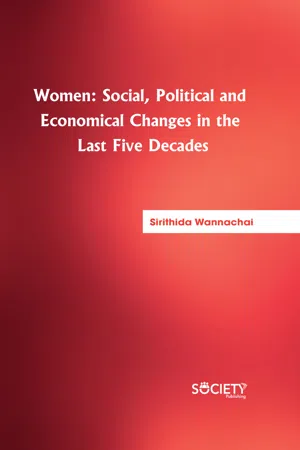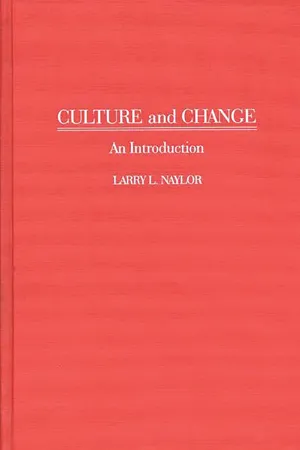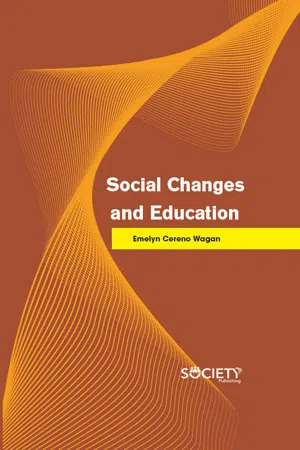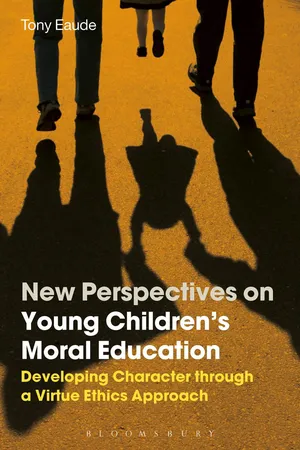Social Sciences
Cultural Change
Cultural change refers to the transformation of a society's beliefs, values, customs, and traditions over time. It can be driven by various factors such as technological advancements, globalization, migration, and social movements. Cultural change is a dynamic process that shapes the way people interact, communicate, and express themselves within a society.
Written by Perlego with AI-assistance
Related key terms
1 of 5
7 Key excerpts on "Cultural Change"
- eBook - PDF
Women
Social, Political and Economical Changes in the last five decades
- Sirithida Wannachai(Author)
- 2019(Publication Date)
- Society Publishing(Publisher)
For example, a specific set of attitudes towards sex, voiced by the priests in the early middle ages, still holds good for the Catholic community. A theory proposed by Dawson and Gettys in 1948 suggests that the culture determines direction and speed to social transformation and determines the limit beyond which social transformation is impossible. For example, if one decides to travel by a ship, the direction of the travel is not predestinated by the design of the ship but by the culture, which determines the direction and the destination Women: Social, Political and Economical Changes in the Last Five Decades 12 both. However, the cultural influence is responsive to technological change, direction, and characteristics. Cultural Change in society has two major aspects: • Cultural Change influenced by invention and discovery, and • Cultural Change influenced by diffusion and borrowing. Cultural Change influenced by invention and discovery emerges from within the society, whereas the change influenced by diffusion happens due to external factor that takes place outside the perimeter of the society. Any invention or discovery, which is acknowledged by the individual living in the society, becomes a factor for social change in the future. For example, information of bacterial infection would devise several changes in the behavior of the individual in the form of prevention and cure of disease. Further, people from other cultures bring the socioCultural Changes in a society. Diffusion could be defined as the range of cultural traits or patterns that exist in an individual group and vary from group to group. When an individual or the community adopts the cultural characteristic of another culture, such adoption could be termed as borrowing. Societies across nation have successfully borrowed many such traits from other culture and have adopted it. For example, usage of fork and knife in the Asian culture is borrowed by western world. - eBook - PDF
Culture and Change
An Introduction
- Larry Naylor(Author)
- 1996(Publication Date)
- Praeger(Publisher)
Chapter 7 DYNAMICS OF CHANGE Throughout this volume, the process of culture change has been presented as a necessary component of all cultures, the means by which culture groups adjust or alter their beliefs, behaviors, or products in response to changing sociocultural cultural or physical environments. Although some of the alterations or adjustments are absolutely essential if a culture group is to remain viable, not all culture change is tied to survival. Some can amount to no more than pseudo change, alterations that do little to impact the basic core systems of culture or are changes in degree, a little more or less of something. To gain some increased understanding of and control over culture change as a dynamic process, it is necessary to look to the actions, forces, or powers that produce it. Most scholars of culture change point to some specific thing(s) as "the" major force(s) that produce(s) change, help(s) or hinder(s) the efforts of people to implement or impact it. Some point to various social, psychological, or generalized "cultural" factors from the cultures of the participants as the major forces influencing the process and helping to produce the outcomes. Still others suggest that the specific actions, usually presented as the role characteristics or strategy of participants, especially those of change agents, are the more significant forces in the process. The position that has been taken in this volume brings all of these things together in the interactional context, suggesting that without interaction, there would be no change. The interactional setting like culture itself, can become a force of its own in the process of change. Putting the emphasis on interaction more clearly focuses on change as a dynamic process. Change is presented as the result of a progression of action and reaction. Perhaps the end result is the intended or designed one, or perhaps it is something else. - H. James Birx(Author)
- 2010(Publication Date)
- SAGE Publications, Inc(Publisher)
W hat is culture change? In a way, the phrase itself is problematic; after all, culture was for-mulated as a scientific concept partly for the very reason that customs seemed resistant to change—at least compared with the confusing blur of particular peo-ple and events traditionally studied by historians (Tylor, 1871/1924, p. 5). Indeed, some anthropologists have tried to analyze cultures as if they did not change at all; such approaches, however, seem ever less relevant in the rapidly globalizing world of the 20th century. In the phrase “culture change,” change has its usual meaning; culture, however, is being used in a sense tech-nical enough to need a bit more discussion here at the out-set. Culture, as classically defined by Edward B. Tylor in 1871, refers to “that complex whole which includes knowledge, belief, art, morals, law, custom, and any other capabilities and habits acquired by man as a member of society” (1871/1924, p. 1). Once we realize that by the word “art” Tylor meant all the artifacts customarily made and used by a society, we see that this is a broad definition indeed: It includes the customary things with which peo-ple surround themselves, the customary ways they interact with one another behaviorally, and the ideas that are more or less shared among them. There are anthropologists, it should be said, who con-sider culture to be things that only an individual can acquire by virtue of being a member of society. One prob-lem with this is that it excludes features that inherently characterize groups rather than individuals—some of which certainly would seem to be fundamental features of a society’s way of life, such as economic inequality, an elaborate division of labor, or (group) religious ritual. Some anthropologists think of culture not only as an acquisition of individuals but also as a particular kind of individual acquisition, namely, mental.- eBook - PDF
- Emelyn Cereno Wagan(Author)
- 2019(Publication Date)
- Society Publishing(Publisher)
This chapter provides with the entire basic introduction related to the role of education in being instrumental for social change. 1.1. INTRODUCTION TO SOCIAL CHANGE Change is known to be a law of life and there is a need to understand that change is the dynamic part of any society. Social change refers to the steady change in the culture of a place and the social setup of a region over a period of time. Society is changing every day and the changes in the society are generally because of different factors like social, economic, political, economic, and Cultural Changes. There are several classic theories and research methods that are present within the study of sociology to understand the different aspect of sociology (Figure 1.1). Figure 1.1: Illustration of change. Introduction to Social Change 3 Source: https://cdn.pixabay.com/photo/2015/12/04/08/18/ change-1076220_960_720.jpg 1.1.1. Characteristics of Social Change There are four important characteristics of sociology that are responsible for change as identified by Macionis 1996 which are given below: • Social change is known to be the change that can happen at any place but the pace the change comes about might differ from place to place. For instance, there would faster changes in countries like the United States with aspects related to computers and technology whereas the changes would be very less in the third world countries where the access to science and technology is extremely less. • Social change is known to be a change that is mostly not planned and happens naturally; however, in certain cases, this change can be planned change which has been aimed for. For instance, the invention of the airplane might have made it clear to people that airplane may increase the speed of air travel but how would this invention change the future of the society would be unknown to the people. - eBook - PDF
- Edward Sapir, Judith T. Irvine(Authors)
- 2011(Publication Date)
- De Gruyter Mouton(Publisher)
Chapter Two The Concept of Culture in the Social Sciences 1. [Methodological Problems in Anthropology] [In the preceding lecture we began to consider] the anthropological sense of the term culture as embracing all those human reactions which are socially inherited, as contrasted with those lacking historical continuity or those based on biological heredity. [You will recall, however, that our] attempt at a closer definition [than Tylor's] led to [a glimpse of some] unexpected difficulties. [Let us examine some of these more carefully now.] [Whatever else culture may be, the anthropologist insists that it is] a continued thing, [transcending the vagaries of] individual experience. For example, although the Minnesota accent [of a Mid-Western schoolboy from a rural background may] change naturally to an Oxford accent [if he should happen to cross the ocean for his university education, this change is merely a personal matter that has little to do with the gradual shifts of pronunciation that take place over the years in the language as a whole.] 1 The English language goes on, with a continuity [of its own that does not depend on the particular events of an individual's personal history. Nor is] the biological sequence [by which our schoolboy passes from] birth to adulthood and [eventual] death [a cultural matter, even though cultural transmission involves the sequence of generations. We must therefore distinguish among at least] three fields of behavior or kinds of continuities: those continuities that are biologically necessary; those that are accidental or contingent; and those that are socialized. [It is the last that represents the] cultural continuities, for culture is in no regard accidental, [insofar as this characterizes that which is] individual and personal, nor does culture concern itself with that which is biologi-cally necessary. - eBook - PDF
New Perspectives on Young Children's Moral Education
Developing Character through a Virtue Ethics Approach
- Tony Eaude(Author)
- 2015(Publication Date)
- Bloomsbury Academic(Publisher)
The world in which I grew up was very different from that in which Imran and Ajaz, as children of Muslim parents who had migrated from Pakistan to England, were living. In this section, I describe social and Cultural Changes in my life time, especially in the UK, though many will be familiar in other countries and cultures. Some relate more obviously to morality, others less. These changes have combined to alter significantly the landscape in which children grow up, and parents, teachers and others associated with their upbringing must work. The process has been gradual and subtle, with ele-ments which different people may see as beneficial or otherwise. This is like how a neighbourhood changes over several years, as old houses are knocked down or renovated, long-standing residents move out and new ones in, with the type of shops, of groups and of activities all changing. One may lament the passing of the old, or welcome the vibrancy of the new, and probably elements of each. Let us consider these changes before trying to analyse the impact on children. The Changing Social and Cultural Context 45 Among key social and Cultural Changes in recent years which the Cam-bridge Primary Review (Alexander 2010, pp. 53–5) highlights are: l changing patterns in both the immediate and extended family and communities; l a much improved level of physical health, though greater concern about mental health; l a higher level of disposable income and possessions for most but not all; l a rapid change in types, and availability, of technology; and l a less deferential approach to authority. In addition, there has been in most industrialized countries a rapid decline in attendance at church, but a more varied pattern of religious affiliation. Being part of faith community has become less common for most children, but, for a substantial minority, religious affiliation remains a significant marker, and maker, of identity. - eBook - PDF
Greening the Globe
World Society and Environmental Change
- Ann Hironaka(Author)
- 2014(Publication Date)
- Cambridge University Press(Publisher)
Finally, the book explores the role of cultural meaning and evolving patterns of conflict in world society theory. World society theory, more World Society and Social Change 5 than other institutional perspectives, stresses the importance of culture, ideas, and meaning. Chapter 5 examines evolving cultural meanings, and their implications for contestation and conflict, focusing on efforts to create a global regime to address climate change from 1992 to the present. The rest of this introductory chapter articulates a world society model of social change that explains how the seemingly weak influences of international institutions and global culture can nevertheless generate dramatic changes in activity around the globe. This approach focuses on myriad loosely coupled factors rather than treating behavior as a direct and proximate consequence of specific treaties or policies and their implementation. Next, the chapter contrasts the world society perspec- tive with dominant explanations of social change in the literature, includ- ing modernization theories and social movement arguments. The chapter concludes by outlining the overall structure of the book. World Society and Social Change: The Strength of Weak Mechanisms A conundrum for scholars seeking to explain major historical transfor- mations is that social change appears to be halting, contested, and par- tial when closely scrutinized. Consider the topics of democratization and gender equality. Close analyses of any democratic society are likely to find failures of effective democracy beneath the facade. Likewise, ongoing gender discrimination can be uncovered even in the most egalitarian soci- eties. Yet when one looks at the forest rather than the trees, tremendous social change has occurred. The past century has seen multiple waves of democratization and huge increases in the social status of women across much of the globe (C. Beck 2011; Ramirez, Soysal, and Shanahan 1997).
Index pages curate the most relevant extracts from our library of academic textbooks. They’ve been created using an in-house natural language model (NLM), each adding context and meaning to key research topics.






